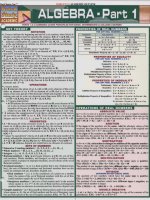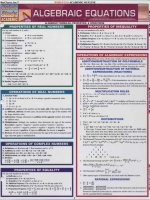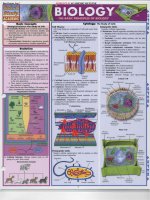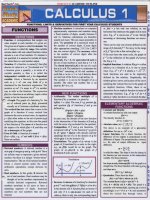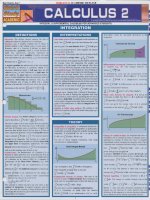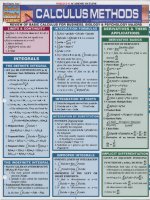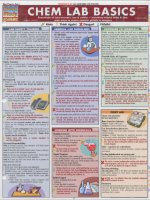Quick study academic calculus methods 600dpi
Bạn đang xem bản rút gọn của tài liệu. Xem và tải ngay bản đầy đủ của tài liệu tại đây (7.82 MB, 4 trang )
REVIEW OF BASIC CALCULUS FOR BUSINESS, BI LOGY & PSYCHOLOGY MAJORS
LIMITS & CONTINUITY
INTEGRATION FORMULAS
DERIVATIVES & THEIR
• lim/(x) = L if /(x) is close to L for all x
I. II/(x) + g(x)ldx = V(x)dx + fg(x)dx
APPLICATIONS
sufficiently close (but not equal) to a.
•/(x) is continuous at x = a if:
l.f(a) is defined,
2. Iim/(x)=L exists, and
2. Ik/(x)dx = kff(x)dx if k is a constant
,,+1
3. u"du= ~+I +C
DERIVATIVE BASICS
x- a
x
0
3. L=f(a)
I
4. I ~du
= Inlul+C
I. /,(a)
"
6.1f y = lex) ~ 0 on la, hI, [I(x)dx gives
·0
THE DEFINITE INTEGRAL
• L ET lex) BE CONTINUOUS ON la, hi
I. Riemann Sum Definition of Definite
Integral
a. Divide la, hi into n equal subintervals
of length
h=b~a.
the area under the curve. b
7.lfJ(x) ~g(x) on la, hI, 1. [f(x)- g(x)ltL\"
gives the area between °the two curves
y = lex) and y = g(x).
8. Average value of f(x) on la, hi is
I
b-a
f."I(x)dx.
9. Volum'e of the solid of re volution
obtained by revolving about the x-axis
the region under the curve y = lex) from
h
b. Let Xo = a, XI ' x 2, .... , x" = h denote the
x=atox=his [ll[/(x)fdx .
·11
endpoints of the subintervals. They are
founu by:
2h,
X3
Xo
= a,
XI
= a + Jr, X2 = a +
= a + 3h, ... , x" = a + nh = h.
c.Let m l ,
"'2 ' .•• m"
denote the midpoints
of the subintervals. They are found by:
ml
INTEGRATION BY PARTS
I. Factor the integrand into two Parts: u and dv.
2. Find du and v = f dv.
3.Find f vdu .
4. Set Judv = uv - Jvdu.
= 0.5(xo + XI)' m2 = 0.5(x l + x 2). 1n3
= 0.5(X2 + x 3). "', mIl = 0.5(x" -1
.b
.
+ x,,).
LI(x)dx:::::hlf(m )+f(m2)+'" +/(m,,)I.
l
b
2. Midpoint Rule: {I(x)dx =
"0
limhl/(x l ) + /(x 2 ) + ...+ /(x,,) I
".
(h
" 1/(xO) +
3. Trapezoid Rule: -",I(x)dx:::::
2
2/(x l ) + 2/(X2) +... + 2/(x,,_I) + /(x,,) I
h 1/(xo)+
["
4. Simpson's Rule: ."/(x)dx:::::
3
4/(m l ) + 2/(x l ) + 4/(m 2 ) + 2/(x 2) +... +
2/(x,,_I)
INTEGRATION BY SUBSTITUTION
• TO SOLVE V(g(x»g'(x)dx
I . Set u = g(x) , where g(x) is chosen so as
to simplity the integrand.
2. Substitute u = g(x) and (Iu = g'(x)tL\" into
the integrand.
a. This step usually requires multiplying
or dividing by a constant.
3. Solve V(II)du = F(u) + C.
4. Substitute II = g(x) to get the answer:
F(g(x»+c.
+ 4/(m,,) + j(x,,>1
IMPROPER INTEGRALS
• INFINlTE LIMITS OF INTEGRATION
THE INDEFINITE INTEGRAL
• F(x) IS CALLED AN ANTIDERIVATIVE
OF /(.i), iF P(x) = lex)
I . The most general anti derivative is
denoted V(x)dx.
2. V(x)dx is also called the Indefinite
Integral oflex).
• Fundamental Theorem of Calculus
I. If P(x) = f(x) and/(x) is continuous on
b
[a , h], then [I(x)dx = F(h) - F(a).
·0
I.
f.'
II
oc
"-00
.h
a
2. L oo/(x)dX= !i"!.~/(x)dx
"
[I(x)dx
=
.h
~~.
• FORMULAS:
I. Power Rule: dd (x") =
d
2. dx(e"-'")
= ke kx
3. :/x(/1L\')
=~
x
"X,,·I
4. General Power Rule:
d
dx(I/(x)I") = 1l1/(x)I,,·I/,(x)
5. dd lef(x») = ef(""Ij'(x)
x
d
f'(x)
6. dx Iin/(x)] = I(x)
7. Sum or Difference Rule:
,
8. Constant Multiple Rule:
"
..4.... 11if(x)] = k/,(x)
II
dx
9. Product Rule:
•
~
:fx I/(x)g(x) I =/'(x)g(x) + j(x)g'(x)
] O.Quotient Rule:
..4....[.I(X)j= f'(x)g(x)- I(x)g'(x)
dx g(x)
Lg(x)] 2
I I.Chain Rule:
d
dx l/
·
dy
dy
W'\"))] =j'(g'\"»)g" '\"), or dx = du
du
• dx
12. Derivative of an inverse function:
dx
dy
=
I
dy
dx
IMPLICIT DIFFERENTIATION
• GIVEN AN EQUATION INVOLVING
I. DilTerentiatc both sides of the equation
with respect to x. treating y as a function of
X and applying the chain rule to each term
involvingy (i.e.
ft: I/(y)] = /,(y) ~~) .
~~~
to left sidl: and
11
2. If lex) is discontinuous
"
.iI
1.,,1(x)dx = 1!~"!j"/(x)dx.
C
:/xlf(X) ± I:(x) I = /'(x) ±g'(x)
2. Move all terms with
limj I(x)dx.
h - .II
denoted
lX
h
·IMPROPER AT THE LEFT OR
RIGHT ENDPOINTS
I. If lex) is discontinuous at x = h,
• (l
2. If Y = f(x), thc deri vative /'(x) is a lso
FUNCTION OF x AND)" TO FI N D: dlY
I(x)dx= lim 1.f(x)dx
(J
= Iim/(a+/~- 1(0)
h ·0
5. Ieudu = eU+C
INTEGRALS
• DEFINITION OF DERIVATIVE
at x = a,
all other terms to the right.
3. Sol ve for
~~.
C
~
;
~&I"'4~
•
APPROXIMATIONS &
DIFFERENTIALS
CURVE SKETCHING
• STEPS TO FOLLOW IN SKETCHING
THE CURVE y = lex):
I. Determine the domain of/ex).
2. Analyze all points where lex) is
discontinuous. Sketch the graph near all
such points.
3. Test for vertical, horizontal and oblique
asymptotes.
a.f(x) has a vertical asymptote atx = a if:
limJ(x) = ±co or lim/(x) = ±co.
x- a
x- a
b.f= (x) has a horizontal asymptotey = h if:
lim/(x) = h or lim lex) = h.
x - co
X -
-:;o
c. Sketch any asymptotes.
4. Findl'(x) and/"(x).
5. Find all critical points. These are points
x=a where I'(a) does not exist or
/,(a)=O. Repeat steps 5.a. & 5.b. for
each critical point x = a:
a. Iflex) is continuous at x = a,
i./(x) has a relative maximum at x = a if:
(a). /,(a) = 0 and/"(a) < 0, or
(b). /'(x) > 0 to the left of a and
/'(x)
(a). /,(a) = 0 and/"(a) > 0, or
(b). /'(x) < 0 to the left of a and
/'(x) > 0 to the right of a.
b.Sketch/(x) near (a,/(a».
6. Find all possible inflection points. These
are points x = a where /"(x) does not
exist or /"(x) = O. Repeat steps 6a. & 6b.
for each such x = a:
a. lex) has an inflection point at x = a if
lex) is continuous at x = a and
i.f"(x) < 0 to the left of a and/"(x) > 0
to the right of a, or
ii. /"(x) > 0 to the left of a and /"(x) < 0
to the right of a.
b.Sketch/(x) near (a,/(a».
7. If possible, plot the x- and y- intercepts.
8. Finish the sketch.
OPTIMIZATION PROBLEMS
• TO OPTIMIZE SOME QUANTITY
SUBJECT TO SOME CONSTRAINT:
I. Identify and label quantity to be
maximized or minimized.
2. Identify and label all other quantities.
3. Write quantity to be optimized as a
function of the other variables. This is
called the objective function (or
objective equation).
4. If the objective function is a function of
more than one variable, find a constraint
equation relating the other variables.
5. Use the constraint equation to write the
objective function as a function of only
one variable.
6. Using the curve sketching techniques,
locate the maximum or minimum of the
objective function .
ELASTICITY OF DEMAND
• LETy=/(x)ANDASSUME/,(a) EX]STS
I. The Equation ofthe Tangent Line to y = /(x)
at the point (a,/(a» is y - lea) = /,(a)(x-o).
2. The differential ofy is dy = /,(x)dx .
3. Linear Approximation, or Approximation
by Differentials. Set dx = ~x = x - a,
~y = lex) - lea).
The equation of the tangent line
becomes:
~y = /,(a)~x = /,(a)dx. If ~x is small,
then ~y::::: dy.
That is,/(x) ::::: lea) + /,(a)(x - a).
4. The nth Taylor polynomial of/ex) centered
at x
=a
.
IS Pn(x)
= lea) +
j"(0)(X-O)2
2!
/'(o)(x-a)
l!
+
• SOLVING FOR X IN THE DEMAND
EQUATION P = p(x) GIVES x =/(p)
I. Demand function which gives the
quantity demanded x as a function of
the price p.
2. The elasticity of demand is:
£(P) = -p/'(p)
j(p)
• DEMAND IS ELASTIC AT P = pO IF
£(pO) > 1
In this case, an increase in price
corresponds to a decrease in revenue.
• DEMAND IS INELASTIC AT P = pO IF
£(pO) < 1
In this case, an increase in price
corresponds to an increase in revenue.
j (I )(O)(X-O)"
+...+
n!
MOTION
• FORMULA
If s = S(I) represents the pOSItIOn of an
object at time I relative to some fixed point,
then V(/)=s'(/) = velocity at time I and
a(/) = v'(I) = S"(/) = acceleration at time I.
CONSUMERS'SURPLUS
• IF A COMMODITY HAS DEMAND
EQUATION P = p(x)
Consumers' Surplus is given by
Ip(x)
Jfa
o
- p(a)ldx where a is the quantity
demanded andp(a) is the corresponding price.
EXPONENTIAL
MODELS
COST, REVENUE & PROFIT
I. C(x) = cost ofproducing x units ofa product
2. P = p(x) = price per unit; (p = p(x) is
also called the demand equation)
3. R(x) = xp = revenue made by producing
x units
4. P(x) = R(x) - C(x) = profit made by
producing x units
5. C(x) = marginal cost
6. R '(x) = marginal revenue
7. r(x) = marginal profit
EXPONENTIAL GROWTH
& DECAY
• EXPONENTIAL GROWTH: y = Poe'"
I. Satisfies the di tfcrential equation y' = ky
2. Po is the initial size, k > 0 is called the
growth constant.
3. The time it takes for the size to double is
given by:
• EXPONENTIAL DECAY: y = Poe-At
I. Satisfies the differential equation y' = -"-y .
2. Po is the initial size, A > 0 is called the
decay constant.
3. The half life 11/2 is the time it takes for y
to become Po/2. It is found by
COMPOUNDING INTEREST
amount is: P = Po(1 + :;')ml.
2. If interest is continuously compounded,
m~co and the formula becomes:
P
=
lim P o(1 + :;')mt = P
m
= Poe rt .
""
3. The formula P = Poe rt gives the value at
the end of t years, assuming continuously
compounded interest. Po is called the
present value of P to be received in I years
and is given by the formula Po = Pe-rt .
2
11/2
=
~l = 112.
• STARTING WITH A PRINCIPAL Po
I. If the interest is compounded for I years
with m periods per year at the interest
rate of r per annum, the compounded
l~2.
OTHER GROWTH CURVES
• THE LEARNING CURVE:y = M(1--e- k/ )
Satisfies the differential equation y' =
k(M-y) , yeO) = 0 where M and k are
positive constants.
• THE LOGISTIC GROWTH CURVE:
y
=
M_Mkl
l+Be
sati sfies the ditlerential
equation y' = ky(M-y) where H, M and k
are positive constants.
DOUBLE INTEGRALS
PROBABILITY
• If f = f(x, y )
af
af
I. df = ax dx + ay dy = /.,..(x, y )dx +J;,(x, y )dy
For the continuous random variable X is a
function p(x) satistying: And p(x) ~ 0 if
.H
A ::: x::: hand
! p(x)dx=l, where we
·A
assume the values of x lie in lA, BI .
• THE PROBABILITY THAT
a :::X::: h is Pia :::X::: hi
=
I. ."p(x)dx
."
• EXPECTED VALUE, OR MEAN OF X
= E(X) = jAxp(x)dx
.IJ
Given by m
• VARIANCE OF X: Given by 0 2 = var(X)=
l
/J
(x - Il)2P(x)dx
=
l
/J
x2p(x)dx - 112
COMMON PROBABILITY
DENSITY FUNCTIONS
= ~x = x
- a, dy = ~y = y - h
-f(a, h), if ~xand ~yare
both small, then ~f ;:::: df That is :
f (x, y ) ;:::: f (a, h) +/.,..(0, h)~ x +.I;(a, h)~y.
2. Setting dx
and ~f =f(x, y)
RELATIVE EXTREMA TEST
• TO LOCAT E RELATIVE MAXIMA,
RELATIVE MINIM A AND SADDLE
POINT S ON THE GRAPH O F z = f(x, y ).
I. Solve simultaneously:
rx =
0 and
~=
(a, b) = 0 and
~ (a,b) =
integral
(x)
)
iterated Rintegral.{'''( .~ "(.\./(x,y)dy
dx.
2. To evaluate the iterated integral
1=
p(x)= B~A 'Il=E(X)=BiA ,var(X)
(B~2A)2
• EXPONENTIAL DENSITY FUNCTION:
p(x) = Ae- Ax. ]n this case, A = 0, B = 00,
J1 = E(X) = IIA, var(X) = IIA2.
• NORMAL DENSITY FUNCTION:
with E(X) = J1 and vor (X) = 0 2 is:
p(x)
I
l2iia
I
I2ii a
exp
_(x-PI '
e 2(1'"
=
[(X-JlV]
0, apply the
ax
ay
c = axay
a f (ab
)andD=AB - C2,
,
a. lf D > 0 and A > 0, then f (x ,y) has a
relative minimum at (a, h).
b. lf D > 0 and A < 0, then f(x ,y) has a
relative maximum at (a, h).
c. If D < 0, then f (x,y) has a saddle point
at (a, h).
d.lf D = 0, then the test fails./(x ,y) may
or may not have an extremum or saddle
point at (a, h).
THE METHOD OF
LAGRANGE MULTIPLIERS
• WHERE f (x, y ) IS A FUNCTION O F
TWO VARIABLES x AN D Y
I. ~~ is the derivative of f (x, y ) with
respect to x, treating y as a constant.
2.~
is the derivative of f(x ,y) with
respect to y, treating x as a constant.
3.
aax2 { = UY
~ _ o~X
is the second partial
derivative of f(x,y) with respect to x
twice, kee ping y constant each time.
a2 I
a af·
h
d
. I
4 . axay
= oy
oX IS t e secon partla
derivative off(x ,y), first with respect
to x keepi ng y constant, then with
respect to y keeping x constant.
5. Other notati on for partial derivatives:
_ af
_ 02I
_ 02f
fx(X,y) - ax ,f.:Jx,y) - a;'i,h y(X,y) -
ayax.
• SOLVES CONSTRAINED OPTIM IZATION
PROBLEMS. TO
MAXIMIZE
OR
MINIM IZE f(x ,y) SUBJECT TO THE
CONSTRAINT g(x, y)=O
I. Define the new function
F(x, y, A)=f (x, y) +Ag (x ,y).
2. Solve the system of three equations:
aF
a. ax =0,
aF
b.ay=O, and
c. ~~ =0 simultaneously.
This is usually accomplished in four steps:
Step I: Solve a. and b. for A and equate
the solutions.
Step 2: Solve the resulting equation for
one of the variables, x or y .
Step 3: Substitute this expression for x
or y into equation c. and solve the
resulting equation of one variable for
the other variable .
Step 4: Substitute the value found in Step
3 into the eq uation foun d in Step 2. Use
one of the equations from Step I to fi nd
A. This gives the value of x and y.
3
g (x)
That is: t~ = f(x , y ).
"
b.Set: 1= [[F(x ,h(x » F(x ,g(x»j dx.
c. Solve this integral. The integrand is a
function of one variable.
DIFFERENTIAL
EQUATIONS
a22f (a ,b), B = -a2 f
2 (a,b),
=-
2S2
PARTIAL DERIVATIVES
( dxf(X, Y)dY ) dx
•
a. f ind an antiderivative F(x,y) for f(x,y )
with respect to y keeping x constant.
2
• UNIFORM DISTRIBUTION FUNCTION:
t(
'1/
following test.
2. Set A
If I(x, y ) dxdy is equal to the
'1/
O. For each ordered pair (0, h) such that
rx
I. If R is the region in the plane bounded by
the two curvesy =g(x),y = " (x) and the two
vertical lines x = 0, x = h, then the double
• A DIFFERENTIAL EQUATION IS:
Any equation involving a derivative. For
example, it could be an equation involving
~~
(or y', or y'(x», y and x.
• A SOLUTION IS: A function y
that
=
y(x), such
~~, y and x satisty the original equation.
• AN INITIAL VALUE PROBLEM al so
specifies the value of the solution yea) at
some point x = a
• SIMPLE DIFFERENTIAL EQUATIONS
can be solved by separation of variables
and integration. For exampl e, the equation
= g(y) ~~
f(x)
can be written as f(x)dx =
g(y)dy and can be solved by integrating
dy
both sides: .f·I(x)=. f' g(y) dx'
FORMULAS FROM
PRE-CALCULUS
LOGARITHMS &
EXPONENTIALS
I.y = Inx if and only if x = eY = exp(y)
2.lne.<=x
3. e 1n x = x
4. e·\"eY
= eX+.r
x
5. ee = e'(-)'.
Y
6. (ex)y = e'\)'
7. eO = I
8.ln(xy) = In x + In y
9.ln(x/y) = In x -In y
I O.ln(x.l') = y In x
11.1n I = 0
12.lne=1
ALGEBRAIC FORMULAS
1.I f a # 0, the solutions to ax 2 + bx + c = 0
~
.
Z
are gIven by x =
III
-b±./b2 -4ac
2a
.
2.Point-slope equation ofa line:
Y - Yo = m(x -xo)·
Perimeter: The perimeter, P, of a two-dimensional shape is the sum of all side lengths.
Area: The area, A, of a two dimensional shape is the number of squan: units that can be put in the
region enclosed by the sides. Note: Area is obtained through some combination of multiplying
heights and bases, which always form 90" angles with each other, except ill circles.
Volume: The volume, V, of a three-dimensional shape is the number of cubic units that can be
put in the region enclosed by all the sides.
~~--------------~
Square Area:
DEVELOP A PROBLEM
=
~
A = b2 ; If h = 8, then: A = 64 square units.
SOLVING STRATEGY
• Three key issues
1. Understand the business or scientific
principle required to solve the problem.
2.Develop a correct mathematical strategy.
3.Logically approach solving the problem .
• Eight useful steps in problem solving:
I . Prepare a rough sketch or ~ ,lI
diagram based on the subject
J., $
of the problem . For business
applications, sct this up using business
terms; for science, use physical variables.
2. Identify all relevant variables, concepts
and constants.
Note: Do not simply search for the
"right" equation in your notes or text.
You may have to select your own
variables to solve the problem.
3.Describe the problem using appropriate
mathematical relationships or graphs.
4.0btain any constants from the stated
problem or textbook. Make sure you
have all the essential data.
............. S
Hint: You may have extra JlJl
information.
d/dx
5.The hard part: Derive a mathematical
expression for the problem . Make sure
that the equation, constants and data give
the right unit for the final answer.
6. Carry out the appropriate mathematical
manipulation, differentiate, integrate,
find limits, etc.
7.The easy part: Plug numbers into the
equation. Obtain a quick approximate
answer, then use a calculator to _ I
obtain an exact numerical answer.
'J
8.Check the final answer using the
original statement of the problem, your
sketch and common sense; are the units
correct? Sign? Magnitude?
Rectangle Area:
A = hb, or A = [w; If h = 4 and b = 12, then:
A = (4)(1 2), A = 48 square units.
Triangle Area:
A = 1bh; If h = 8 and b = 12, then:
A
= 1 (8)(12), A = 48 square units.
Parallelogram Area:
A = hb; If h = 6 and b = 9, then:
A = (6)(9), A = 54 square units.
b
Trapezoid Area:
A = 1"(bl + b2); If" = 9, bl = 8 and b2 = 12, then:
A = 1(9)(8 + 12), A = 1(9)(20), A = 90 square units.
Circle Area:
A = nr 2 ; If r = 5, then:
A = n(5)2 = (3.1 4)25 = 78.5 square units.
Circumference: C = 21tr; If r = 5, then:
c= (2)(n)(5) = 10(3.14) = 31.4 units.
Pythagorean Theorem:
If a right triangle has hypotenuse c and sides Q and b, then:
(J.
= 0 2 + b2 .
~b
u
Rectangular Prism Volume:
V = [wh; If [= 12, HI = 3 and h = 4, then:
V= (12)(3)(4), V= 144 cubic units.
Cube Volume:
V = e3 ; each edge length, e, is equal to the other edge in a cube.
Ife = 8, then: V= (8)(8)(8), V= 512 cubic units.
Cylinder Volume:
V = n r 2h ; If radius r = 9 and" = 8, then :
V = n(9)2(8), V = (3.1 4)(81 )(8), V = 2034.72 cubi c units.
~
Z
III
6
Ll UJ
free
nu
~w~oa~s.
& at
re s 0 tlUes
r~t' n t' d .
rna}
V = 1nr2h; If r = 6 and h = 8, then:
V= 1 n(6)2(8), V= 1 (3.14)(36)(8), V= 301.44 cubic units.
of Ihts
~fltodu<;~d Of
phrl
1f;l,lSmuto:d in 1111\ IOfm.OI' b}ltn\ mC!Irn..
or rntchllll i ~a l. IlI\;ludtnll
rc..'(lfdmll. lJfllll} m{l:ofmlluofl
m d rcU,c ,,,1 .~s lcm .. ,(hoot
V= (area oftriangle)h; If
12
has an area equal to 1(5)(12), then :
ck~lroul':
I'hCo\''«>P~.
~ h'rato::
IUllten pcnnli,\ il'n Inlm the
f"Ubl,.)hcr
( 200::! 2004 l1a rt huh lilt. B4U7
'Io lll r : t)u.:10 Ib~.....ndemc:d
(.>mUIl., plt'llSC:
u.,cllu,llmd <;ullh IbI,.ul\Jcbuiool8S
:. rcpl..."C,ncrll fOf as.~igned ~11l»" OJ".
.. qUlc 5 U y.com
A u.s. $4.95 CAN. $7.50
l1li Customer Hotline # 1.800.230.9522
=
~
b.:
r-;"
ISBN-13. 978-157222841-2
ISBN-10· 157222841-5
911~lllJll~~llllllI11!IJI111 1 11 1 1Irl il l
HI
[
{1O
e
e
§~}
Cone Volume:
Triangular Prism Volume:
\11 ris: hlS
flubIKal"",
"CbP
V = 30h and if h = 8, then: V = (30)(8), V = 240 eubic units.
..... "
~
:
I
r :·
4
~
Rectangular Pyramid Volume:
V = 1(area of rectangle)"; If [ = 5 and w = 4 the rectangle
has an area of20, then: V= 1(20)" and if" = 9, then:
V = 1(20)(9), V
= 60 cubic units.
Sphere Volume:
V=
~ nr3; If radius r
=
5, then: V =
~(3. 1 4)(5)3, V = 523.3 cubi c units.
r
"
